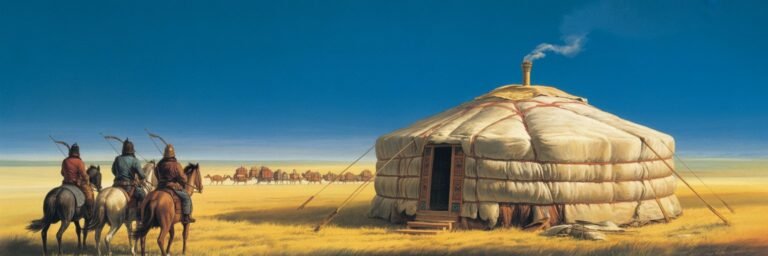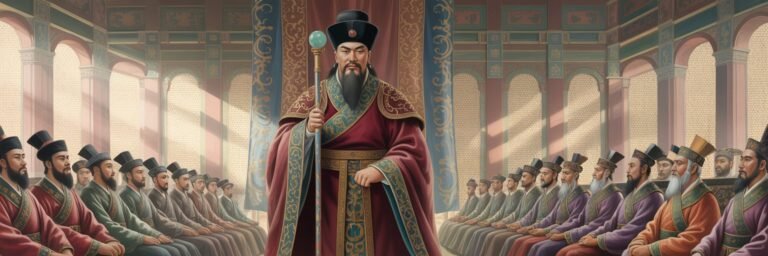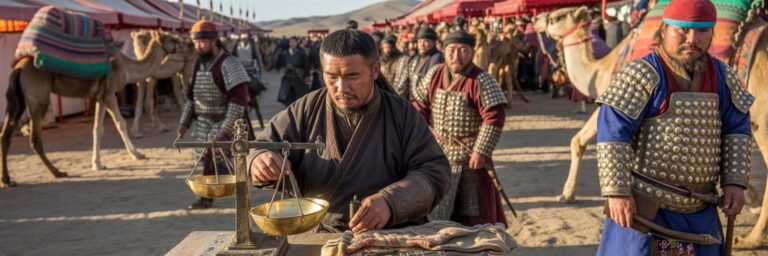INTRODUCTION
The Mongol Empire is a tapestry woven with threads of conquest, innovation, and profound socio-cultural transformation. Rising from the steppes of Central Asia in the 13th century, this expansive dominion became the largest contiguous land empire in human history. Under the leadership of Genghis Khan and his successors, the empire stretched from Eastern Europe to the Sea of Japan, igniting a era of change that resonates to this day. This article charts the course of the Mongol Empire and its world-altering influence, tracing a heritage etched into the annals of global civilization.
HISTORICAL BACKGROUND
The Mongol Empire emerged from modest origins. In the late 12th century, societies in the Central Asian steppes were fragmented, scattered across the vast plains. However, a charismatic leader would soon coalesce these nomadic tribes under a singular banner. Born in 1162 as Temujin, he would later acquire the moniker Genghis Khan, meaning ‘Universal Ruler.’ Through a blend of military prowess, political sagacity, and strategic alliances, Genghis laid the foundations of the Mongol Empire, a dynasty that would soon expand across much of Eurasia.
After Genghis Khan’s death in 1227, the Mongol Empire continued to swell. His sons and grandsons, most prominently Ogedei Khan and Kublai Khan, carried the baton, further expanding their territories. They invaded Persia, China, Russia, undermining existing power structures and implanting Mongol hegemony.
THEORIES AND INTERPRETATIONS
Scholars diverge in their interpretations of the Mongol Empire’s sprawling expanse and its multifaceted impacts. A mainstream view paints the Mongols as harbingers of destruction, highlighting their relentless conquests and the ensuing bloodshed. Tens of millions of lives were lost, and many civilizations were irrevocably crushed beneath the hoofbeats of the Mongol Horsemen.
Yet, some historians argue the Mongol Empire was more than a mere machine of war. Jack Weatherford, in his book ‘Genghis Khan and the Making of the Modern World,’ reframes the Mongols as agents of vitality and innovation. They created new trade routes, rooted out corruption, promoted meritocracy and contributed to a global cultural exchange, influencing everything from European military tactics to Asian cuisine.
MYSTERIES AND CONTROVERSIES
Despite extensive scholarship, the Mongol Empire is shrouded in mystery and controversy. For instance, the location of Genghis Khan’s tomb remains unknown, fueling tantalizing speculation. Some hypothesize it lies beneath the waters of Mongolia’s Lake Burkhan Khaldun, while others suggest it’s hidden amidst the Mongolian steppe.
The Mongols’ near-indomitable military acumen also incites debate. Traditional wisdom states that their success was rooted in superior equestrian skills and the adoption of the compound bow. However, S.J. Turnbull, a noted historian, suggests that the Mongols also incorporated psychological warfare and innovative military strategy to defeat more technically advanced adversaries.
SYMBOLISM AND CULTURAL SIGNIFICANCE
The Mongols left an indelible imprint on the cultural and symbolic landscapes of the lands they conquered. The widely-used “Yam” system, a network of post houses that facilitated swift communication, predates the Pony Express by centuries and stands as a symbolic testament to Mongol efficiency.
The Mongol Empire also blended a melange of cultures, religions, and philosophies. Islam, Christianity, Buddhism, and Shamanism all found a place within its borders. This cultural syncretism subtly shifted the world’s religious landscape, fostering an unprecedented spiritual exchange.
MODERN INVESTIGATIONS
Modern research is shedding new light on the Mongol Empire. Bioarcheological studies, such as those conducted by the Max Planck Institute, reveal the substantial impact of the Mongol conquests on global demographics. Genetic studies estimate that about 0.5% of the world’s population are direct descendants of Genghis Khan, a striking testament to the Empire’s vast reach.
Additionally, climate science offers fresh perspectives on the Empire’s rise. A 2014 study published in the journal ‘Scientific Reports’ used ring-widths of ancient trees from Mongolia to unveil an interesting phenomenon: The Mongol Empire’s expansion coincided with an unusually wet and warm climate which may have fostered increased pasture productivity, aiding the rapid movement of Mongol armies.
LEGACY AND CONCLUSION
The echoes of the Mongol Empire resound in our world today – in the East-West cultural exchange, in the contours of geopolitical boundaries, in the rhythm of global trade, and even in our collective genomic heritage. Their legacy is a complex web of creation and annihilation, unity, and division, a powerful testimony to the human capacity for adaptation and transformation.
The Mongol Empire serves as a mirror to the dichotomies of human civilization, reflecting both our proclivities for conquest and our ability to foster vast networks of communication and exchange. Its remnants, both tangible and intangible, remind us that history doesn’t merely record the march of time – it shapes the world to come, one hoofbeat at a time. As scholars continue to investigate and reassess the Mongol Empire, its multilayered legacy continues to unfold, illustrating an intricate panorama of human civilization and its intertwined destinies.






